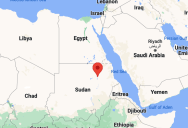What Can We Learn From The World’s Largest Family Tree? Take A Look!
Ancestry has become a pretty mainstream passion, with tens of thousands of people spending their spare time tracing family lines every which way to find out how they ended up where they are now.
If you think about it, tracing family lines for all of humanity would reveal the same types of answers about all of us.
Unlike the family tree you’ve done yourself, which likely traces your family to all sorts of places of origins, every single human eventually traces back here: to a spot of desert in the northeast of Sudan.

Image Credit: Google Maps
It’s not far from the Nile river, and recent research from the Big Data Institute suggests it might be the homeland of every single person alive today.
Dr. Anthony Wilder Wohns, lead author of the published study, explained further.
“Essentially, we are reconstructing the genomes of our ancestors and using them to form a vast network of relationships. We can then estimate when and where these ancestors lived.”
Since the advent of online family trees and readily available DNA analysis became available, scientists have been working on ways to take it global.

Image Credit: Science.org
Now, evolutionary geneticist Dr. Yan Wong says it’s finally happened.
“We have basically built a huge family tree, a genealogy for all of humanity. This genealogy allows us to see how every person’s genetic sequence relates to every other, along all the points of the genome.”
They had to use data from eight different human genome databases to create their network of around 27 million ancestors, and used samples not just from modern humans, but our ancient relatives as well.
“The study models as exactly as we can the history that generated all the genetic variation we find in humans today.”
The resulting visual representation tracks the movement and migration of humans through history, which is fascinating, but they’re not done.

Image Credit: Science.org
They say as data continues to become available they will add and improve the map.
“This study is laying the groundwork for the next generation of DNA sequencing. As the quality of genome sequences from modern and ancient DNA samples improves, the trees will become even more accurate and we will eventually be able to generate a single, unified map that explains the descent of all the human genetic variation we see today.”
And while that seems ambitious and awesome, Wohns thinks it will be a long time before they reach the end of their capabilities.
“While humans are the focus of this study, the method is valid for most living things; from orangutans to bacteria. It could be particularly beneficial in medical genetics, in separating out true associations between genetic regions and diseases from spurious connections arising from our shared ancestral history.”
Anyone who is interested in DNA and ancestry is sure to be watching for what comes next.

Sign up to get our BEST stories of the week straight to your inbox.




